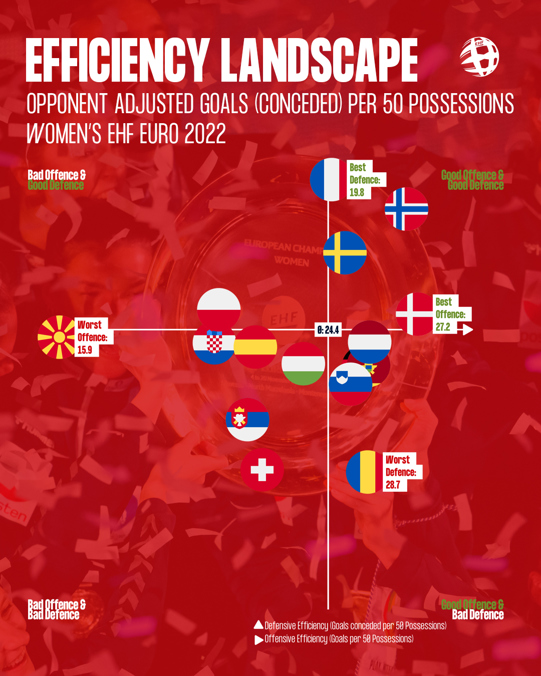The big favourites heading into EHF EURO 2024 are defending European and Olympic champions Norway, and world champions France. Fittingly, they were amongst the most statistically striking teams of the last EHF EURO.
France were defensively outstanding and had the best defence of the tournament as they only allowed opponent-adjusted 19.8 goals conceded per 50 possessions. Norway was the only team that was outstanding on both sides of the field, ranking second in both offence and defence with opponent-adjusted 26.8 goals scored per 50 possessions and 20.7 goals conceded per 50 possessions.
Using statistics adjusted for possessions played is significantly more meaningful than just the raw number of goals (conceded) because it makes the teams actually comparable since the raw number of goals is not only influenced by efficiency, but also by the number of possessions (whether a team and their opponents play rather fast or slow). Since a game has roughly 50 possessions on average (54.4 at EHF EURO 2022), the values here are calculated on 50 possessions so that they roughly reflect those of a game.
In addition, the numbers are adjusted for the opponents’ strength, which makes a comparison between teams fairer in competitions such as the EHF EURO, because not every team played the same opponents.
The adjustment is done by calculating how many goals (conceded) per 50 possessions would be expected for each game and team by the number of goals the opponents scored and conceded per 50 possessions in their other games. So-called “garbage time”, when the game is already decided, is also filtered out. The differences to the actual goals scored and conceded can then be added to the goals scored or conceded per 50 possessions to have an adjusted rating.
The big favourites
France’s defensive statistics were among the best in almost every category. They had the lowest opponent shooting percentage at 50.9 per cent, second-best save percentage at 35.9 per cent and forced the second most turnovers with 13.9 per 50 possessions. In addition, they forced their opponents to the second long possessions with 35.6 seconds on average.
Offensively, however, they were average in every statistic which resulted in opponent-adjusted 24.5 goals per 50 possessions, which ranked just ninth.
It is therefore clear where the new coach Sébastien Gardillou needs to make adjustments. The players, on the other hand, have plenty of continuity. The players who played 77.7 per cent of the minutes in 2022 are back. However, goalkeeper Cléopatre Darleux absent – she had the second best save percentage with 37.4 per cent in 2022 – an integral part of their outstanding defence from two years ago is missing.

Finding a Norwegian weakness at the EHF EURO 2022 was impossible as they were very good in every way and deservedly won the tournament. However, they have the biggest player turnover of all the teams in the wider group of favourites.
Only the players who played 53.5 per cent of the minutes two years ago are still playing this year. Stars like Stine Oftedal and Nora Mørk, who was the best scorer from seven-metre penalty throws with 3.5 per game or an outstanding 96.6 per cent, are missing. Though they have added a lot of experience in the form of Camilla Herrem and Kari Brattset Dale and of course still have MVP Henny Reistad.
Even though Norway won the tournament two years ago in the final against Denmark, Denmark were victorious in their first match in the main stage and thus were the only team to defeat Norway. They are once again among the favourites this year. They were very strong in offence, their opponent adjusted 27.2 goals per 50 possessions were even the best of the tournament.
Defensively Denmark ranked fifth with opponent-adjusted 23.9 goals conceded per 50 possessions. With just 51.9 possessions per game their matches were the third slowest, but that obviously helped their offence.
The wider circle of favourites
Perhaps the most interesting team at the EHF EURO 2022 in terms of numbers were the Netherlands. They played the fastest with 25.5 seconds per possession, but at the same time forced their opponents to play the third longest possessions with an average of 35.6 seconds. This led to the best shooting percentage of the tournament at 63.9 per cent and the third-best offence overall with an opponent-adjusted 25.7 goals per 50 possessions. Defensively, however, it was only enough for 7th place with opponent-adjusted 24.8 goals conceded per 50 possessions.
It will be very interesting to see how they play under new coach Henrik Signell. He will definitely have to restructure his team in some positions: 61.4 per cent of the minutes from two years ago are back.
Sweden have the most continuity. The players who played 84.2 per cent of the minutes from two years ago are back again this year. Coach Tomas Axnér can build on a foundation in which not everything went smoothly in attack, opponent adjusted 24.9 goals per 50 possessions was only the eighth best. Defensively, they were much better and had the third-best defence with 22.0 opponent-adjusted goals conceded per 50 possessions.
For Germany, only 61.3 per cent of the minutes are back, although Antje Döll, for example, did not participate. In both attack and defence, they achieved an opponent-adjusted rating of 25.5 goals and goals conceded per 50 possessions, which meant sixth place in attack and only 12th place in defence. Led by Alina Grijsseels, who was Germany’s top scorer of EHF EURO 2022 with 7.3 goals per game, their offence was OK. But if they want to reach the semi-finals, coach Markus Gaugisch's team needs to improve defensively.
Even if they are mostly not considered one of the bigger favourites, Montenegro must of course also be mentioned when talking about the EHF EURO 2022. Led by the now-retired Jovanka Radicevic, who played an average of 58.9 minutes in seven games, more than any other player, they finished third and beat France in the match for bronze.
They owed this mainly to their good attack, which was the fourth best of the tournament with opponent adjusted 25.7 goals per 50 possessions, while defensively they had problems and finished 11th with 25.5 goals conceded per 50 possessions. So, this is where new coach Suzana Lazović needs to get to work.
More from data analyst Julian Rux can be found at Handballytics.de. There you can read his latest articles, in which he analyses all kinds of handball topics from new, data-based perspectives. You can also find him on Instagram, Bluesky, Threads and WhatsApp channels.
Photo © Kolektiff Images







